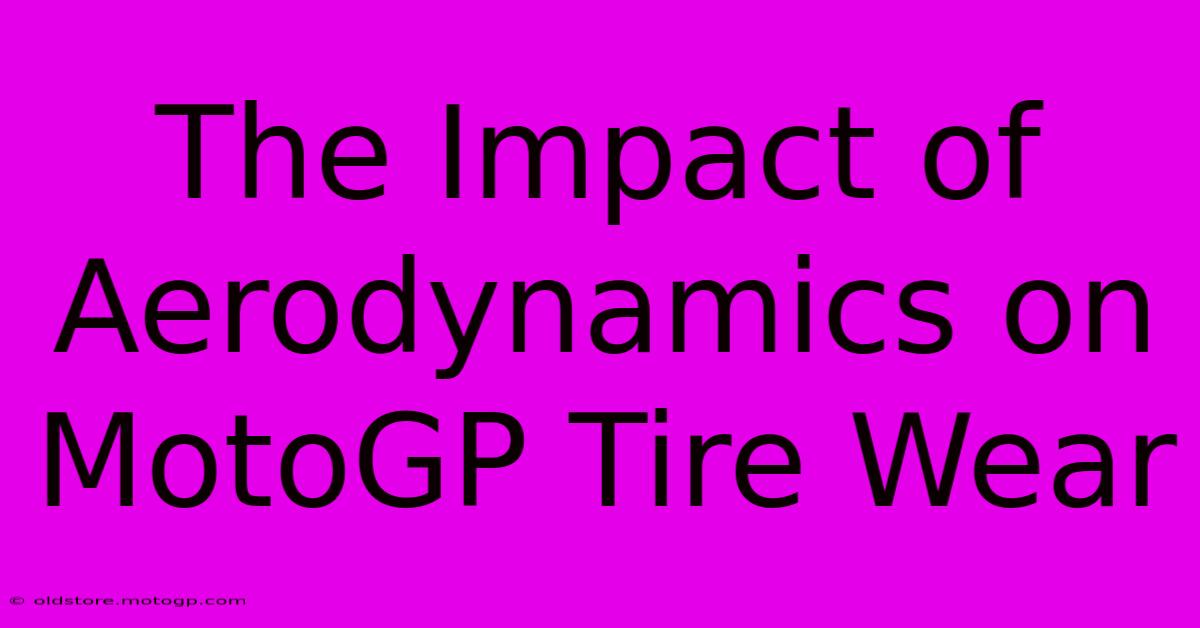The Impact Of Aerodynamics On MotoGP Tire Wear

Table of Contents
The Impact of Aerodynamics on MotoGP Tire Wear
MotoGP racing is a relentless battle for milliseconds, where every aspect of bike performance is meticulously optimized. While rider skill and engine power are paramount, the often-overlooked impact of aerodynamics on tire wear significantly influences race strategy and results. This article delves into the complex relationship between aerodynamic forces and tire degradation in MotoGP.
Understanding the Aerodynamic Forces at Play
MotoGP bikes generate substantial aerodynamic forces at high speeds. These forces, primarily downforce and drag, interact in complex ways to affect tire wear.
Downforce: The Grip Trade-off
Downforce, the force pushing the bike towards the track, is crucial for high-speed cornering. Increased downforce provides greater grip, allowing riders to lean further and carry more speed through turns. However, this increased grip comes at a cost. The higher pressures on the tires, particularly the front, lead to increased tire wear, especially in areas like the shoulders and crown. Aggressive aerodynamic devices, like winglets and aero fairings, designed to maximize downforce, exacerbate this wear.
Drag: The Energy Thief
Drag, the resistive force opposing the bike's movement, slows acceleration and increases fuel consumption. While it doesn't directly impact tire wear in the same way as downforce, drag indirectly influences tire degradation. By increasing the energy required to maintain speed, drag puts more strain on the engine and consequently, on the drive train, which in turn transmits more forces to the rear tire, accelerating wear.
How Aerodynamic Balance Affects Tire Wear
The balance between downforce and drag is critical. A bike with excessive downforce on the front may lead to rapid front tire wear, while too much rear downforce can overheat and excessively wear the rear tire. Optimizing this balance is an ongoing challenge for MotoGP teams.
Front vs. Rear Tire Wear
The front tire generally suffers more from aerodynamic effects due to the higher downforce generated at the front of the bike. The aggressive lean angles in corners, combined with the pressure from aerodynamic forces, creates significant stress points on the front tire's contact patch. The rear tire also experiences considerable wear, but its wear pattern is often more influenced by acceleration, throttle application, and engine torque.
Technological Advancements and Tire Management
MotoGP teams constantly develop aerodynamic solutions to minimize tire wear. This involves:
- Sophisticated CFD (Computational Fluid Dynamics) simulations: These simulations help engineers optimize aerodynamic designs to achieve the ideal balance between downforce and drag.
- Adaptive aerodynamic elements: Some bikes feature adjustable aerodynamic components, allowing teams to tailor the aerodynamic balance to different track characteristics and weather conditions. This dynamic adjustment helps manage tire wear more effectively according to specific circuit demands.
- Tire pressure monitoring and adjustment: Real-time data on tire pressure and temperature allows teams to make informed decisions about tire changes and pressure adjustments, mitigating excessive wear.
The Future of Aerodynamics and Tire Technology
The interplay between aerodynamics and tire wear continues to be a hot topic in MotoGP. Future developments will likely focus on:
- More efficient aerodynamic designs: The pursuit of higher downforce with minimal drag will continue, minimizing the negative impact on tire life.
- Advanced tire materials: Tire manufacturers are constantly developing compounds that offer greater durability and resistance to wear, reducing the impact of high aerodynamic loads.
- Improved tire management strategies: Data analysis and advanced simulation tools will enable teams to implement even more precise tire management strategies, optimizing performance while extending tire life.
In conclusion, aerodynamics plays a crucial, often underestimated role in MotoGP tire wear. Understanding the complex relationship between downforce, drag, and tire degradation is essential for teams striving for optimal performance and race-winning strategies. The continuous evolution of aerodynamic technology and tire compounds will undoubtedly shape the future of this thrilling motorsport.

Thank you for visiting our website wich cover about The Impact Of Aerodynamics On MotoGP Tire Wear. We hope the information provided has been useful to you. Feel free to contact us if you have any questions or need further assistance. See you next time and dont miss to bookmark.
Featured Posts
-
Moto Gp Accident The Importance Of Track Design
Feb 24, 2025
-
Circuit Of The Americas Where F1 Fashion Meets Passion
Feb 24, 2025
-
Motorcycle Racing A Comprehensive Overview Of Race Types
Feb 24, 2025
-
Grand Prix Results Find Out Who Took Home The Gold
Feb 24, 2025
-
Moto Gps Champions Celebrating The Best Riders
Feb 24, 2025
